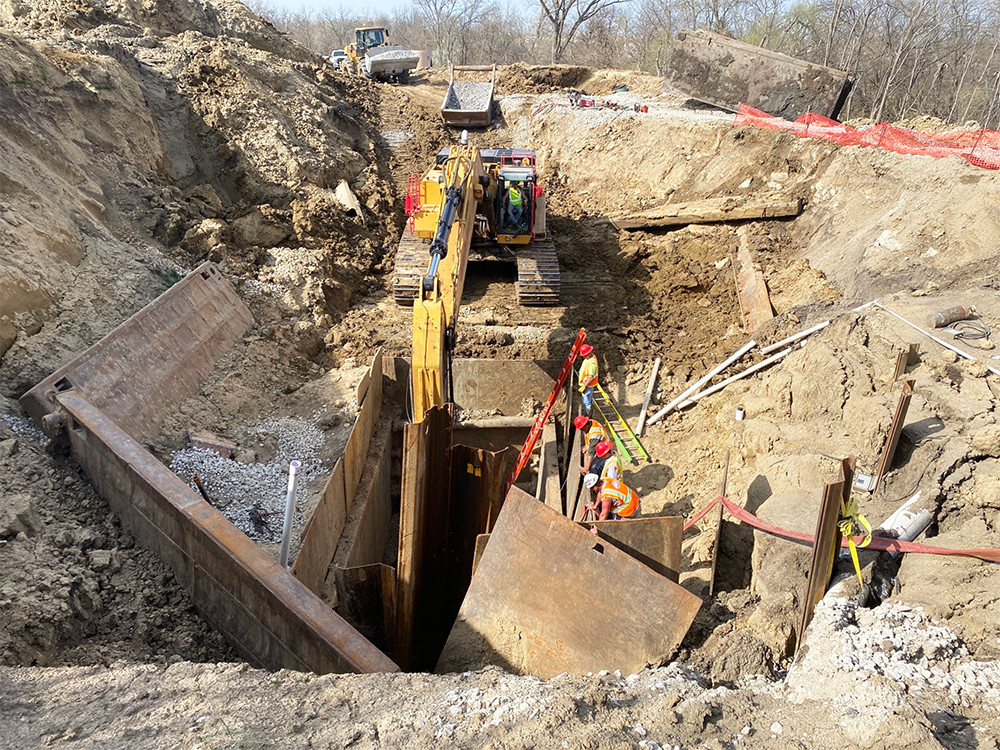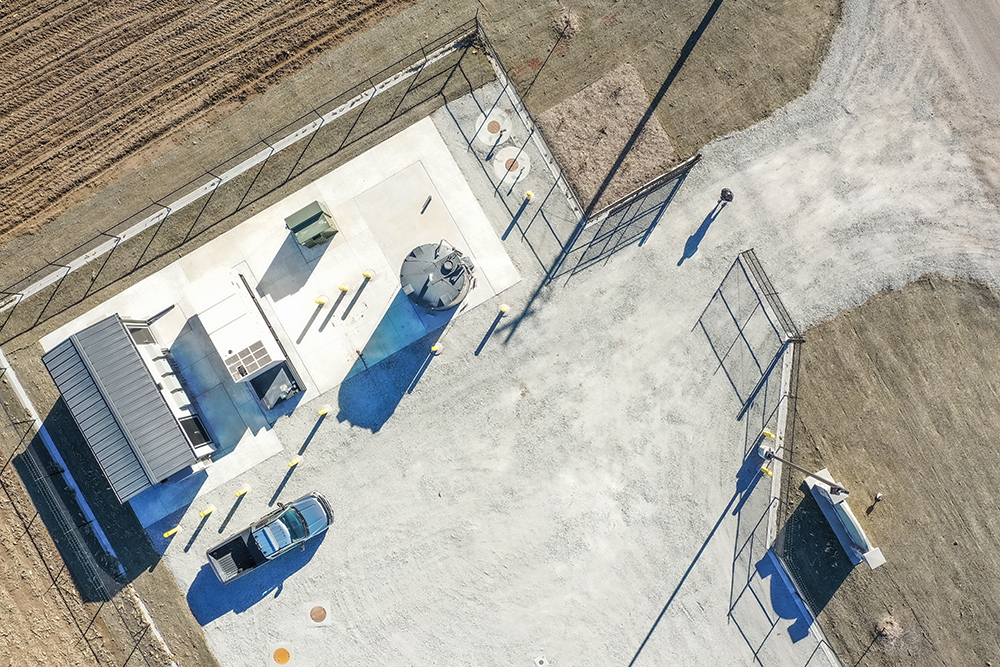April 2025 Vol. 80 No. 4
Features
Nebraska communities unite to build regional wastewater system, opening path for growth
By Thomas Renner
(UI) — Only one problem prevented Sarpy County, Neb., from opening the region to residential and commercial development. The problem, though, was a big one.

A hydrologic ridgeline running from east to west divided the northern and southern sections of the county. North of the ridgeline, water flowed to Papillion Creek and a sewer system sent wastewater north to Omaha’s treatment facilities. South of the ridgeline, the county lacked wastewater services, hindering development and preventing the region from reaching its full potential.
Recently, that all changed.
The Sarpy County and Cities Wastewater Agency commissioned the first phase of the Unified Southern Sarpy Wastewater System into formal operation. The $130-million project delivered 45 total miles of sewer lines and three lift stations, and is the initial step toward bringing significant development to the area. The government body includes Sarpy County and five cities – Bellevue, Gretna, La Vista, Papillion and Springfield.
Prior to the system, wastewater treatment mechanisms south of the ridgeline relied on disjointed approaches among the communities. The new approach brought together five cities and Sarpy County to tackle the issue as a unit. The collective helped solve a problem that the communities wrestled with for decades.
“This effort is a regional solution that no jurisdiction could tackle alone,” said chairman of the Wastewater Agency and a Sarpy County Commissioner, Don Kelly. “It has taken cooperation and partnership to get here, and I’m pleased to stand alongside our neighbors to create this system that will benefit not only Sarpy County and the Omaha metro area, but the state of Nebraska as a whole.”
Ridge woes
Going back to 2004, Sarpy County started developing plans for a unified approach to wastewater management. That’s when the Papio-Missouri River Natural Resources District approved an interlocal agreement with Sarpy County and others to study the water and wastewater treatment needs for the region.
A regional summary released in 2016 outlined the issues facing communities on the region’s southern ridge. Three communities – Gretna, Papillion and Bellevue – collected and pumped over the ridgeline to the Papillion Creek watershed. It was then conveyed to the treatment plant in Omaha.
South Bend discharged to Fountain Creek, and subsequently to the Platte River. In Springfield, wastewater was conveyed through the Springfield Creek watershed to a wastewater treatment facility. A shopping mall and other developments in the southwest area of the county were collected and conveyed to a treatment plant, where it was discharged into a tributary of Buffalo Creek and eventually to the Platte River. Wastewater from single-family developments throughout other parts of Sarpy County was treated and infiltrated through private septic systems.
The summary saw several challenges in developing a comprehensive solution. “For example, the ability to pump over the ridge is generally a less costly, short-term solution (on a case-by-case basis),” the report said. The summary also found growth pressure was on the upstream end and scattered across the watershed.
The overwhelming ridgeline – more than 30 miles long and 1,280 feet above sea level at its highest point -- had stunted growth, but inaction was not an option.
“As growth in Sarpy County continues to consume developable area north of the hydrologic ridgeline, growth pressure will redirect to southern Sarpy County,’’ the report said. “In order to support the impending growth, wastewater service south of the ridgeline is essential.”
The best solution was a unified approach among the five communities and the county. It was up to them to make it work.

Getting started
After years of discussion, the project formally began with the creation of the Sarpy County and Cities Wastewater Agency (SCCWA) in 2017. Construction began in April 2022 and was funded with several sources.
The primary investment came from a $69.8-million, zero-interest state revolving fund loan from the Nebraska Department of Environment and Energy. The agency also secured $4.5 million in congressionally directed spending sponsored by Congressman Don Bacon. Additional funds were acquired through low-interest loans. The system is expected to cost approximately $620 million and will be built in phases over the next 10 to 50 years.
The project consists of a gravity sewer system, force mains and lift stations to get sewage across the southern part of Sarpy County.
“We’ve got about 21 and a half miles of linear distance between all of the facilities,’’ said Jeff Thompson, project engineer. “We have two sewer lines parallel from our Springfield lift station all the way to the city of Omaha’s wastewater treatment plan. In total, we have almost 45 miles of pipe in the ground.”
Acquiring the land to install the sewer lines posed one of the most significant challenges in the project.
“There were some pretty poor soil conditions, and land rights and easement acquisitions are always a challenge when you’re spanning 21.5 miles,’’ Thompson explained. “Most of it was in private agricultural fields in rural areas. Folks don’t necessarily want to give up that land. We acquired a little over 100 easements and right-of-way acquisitions, and we really didn’t have a whole lot of opposition.”
With all the various pumps, systems and mechanical equipment, an important part of the project was providing access for maintenance and repair.
The project includes 31 stainless steel floor doors from BILCO, a manufacturer of specialty access products. The doors were specified in a range of sizes and equipped with fall protection grates.
“We wanted something that was going to provide a high level of security,’’ Thompson said. “We don’t want somebody falling into some of these areas. And they secure the equipment needed to facilitate the movement and conveyance of our sewers. They’re very functional and easy to operate.”
Schu Marketing of Minnesota, BILCO’s manufacturer’s representative, provided the products for subcontractor Hawkins Construction Company. HDR worked with the SCCWA to build the system.

Open for business
At 241 square miles, Sarpy County is the state’s geographically smallest community. Still, it has seen its population double since 2000. And more people are on the way.
The agency expects the system, when complete, will open 97,000 new parcels for development. It will also significantly improve the region and the state’s financial picture. According to the SCCWA, the Sarpy County cities will generate $21 million in annual sales tax revenue and $31 million annually in property tax revenue. Sarpy County itself will generate another $29 million annually in property tax revenue. The state is expected to gain $74 million annually in sales tax revenue.
In the end, it took careful consideration and cooperation among the communities to figure out how to solve the issue with the ridgeline and develop a regional plan that benefits everyone.
“They all want development in their communities,” Thompson said. “Who comes first and how that happens was certainly a big challenge. There were also funding issues. All the cities and the county certainly didn’t have the resources to be able to provide a large bucket of money for us to pay for that. We’ve got a fair amount of debt service right out of the gate, but it’s coming together well, and we’ve got a great plan and model to keep everything on track.”
ABOUT THE AUTHOR: Thomas Renner writes on building, construction and other trade industry topics for publications throughout the United States.




Comments